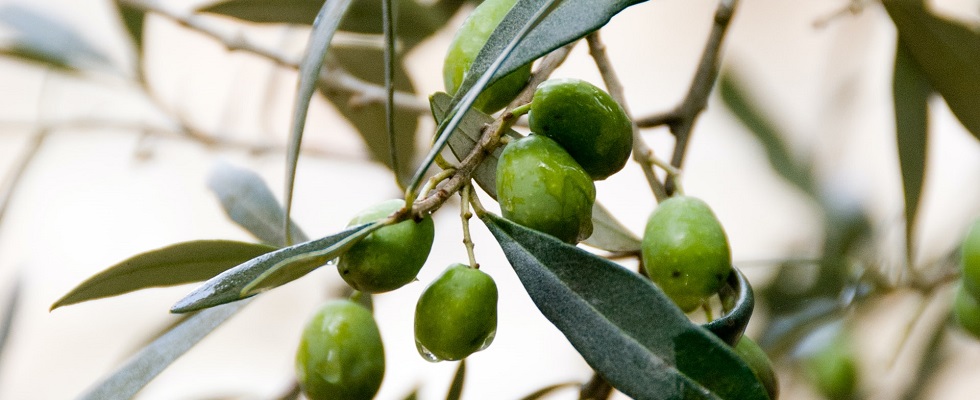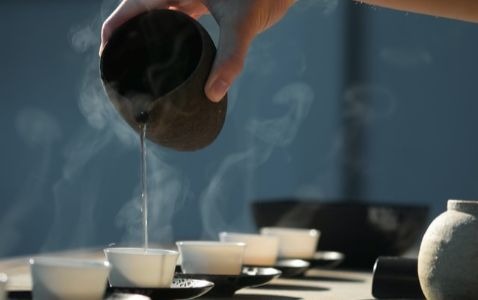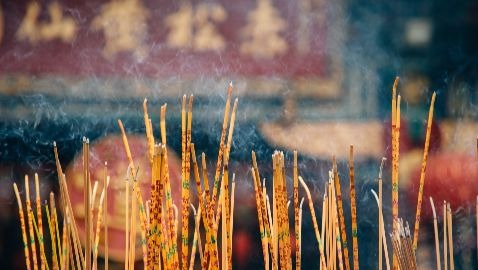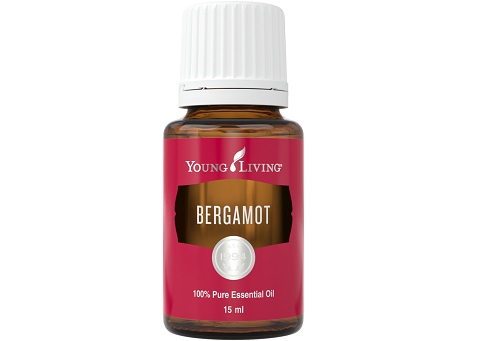Today, bergamot is best known as an essential oil and for being one of the main ingredients in Earl Grey tea. What is less well-known is that people have been utilising bergamot for thousands of years. From ancient Asia to modern-day aromatherapy, you'll be surprised to see how far bergamot has come and how many different uses it has had throughout history!

What is Bergamot?
In general, when most people think of bergamot, they primarily think of the citrus tree that grows in Italy. In actuality, there are two different kinds of bergamot: one is the citrus tree, while the other is a herb that grows in North America. The bergamot citrus tree, scientifically known as Citrus bergamia, is a small tree that only blooms in the winter. The bergamot tree produces a specific type of citrus fruit that is roughly the size of an orange, is the color of a lemon when ripe and is often shaped like a pear (2). Some have conjectured that this type of bergamot is a hybrid between a lemon and a lime, while others believe that bergamot is a hybrid-cross between lemon and grapefruit (2).
In contrast, the bergamot herb found in America, Monarda fistulosa or Monarda didyma, is a type of wildflower that is part of the mint family (4). The bergamot herb, also commonly referred to as wild bergamot, grows throughout the North American continent. This wildflower blooms pink and lavender flowers. Although it does not produce fruit, it is known to be highly attractive to both bees and hummingbirds (4). The two types of bergamot share the same name but are two very different plants. As such, they have distinct chemical compositions. Citrus bergamot is composed of neoeriocitrin, naringin, ponceritin and mitrocin (3). In contrast, the bergamot herb is composed of p-cymene, thymol, a-pinene, b-pinene and citronellyl acetate (7). Although these differing compositions have produced unique results, history has shown that both types of bergamot have been useful throughout time.

Bergamot Across Time
The bergamot citrus tree is believed to have originated in Southeast Asia, which is where all citrus trees originally came from. It is believed that bergamot was brought out of Asia to Persia along the Silk Road (7). From there, bergamot was taken to different countries surrounding the Mediterranean, such as Greece, and continued from there. There are no exact dates for when this happened but it is likely that bergamot was introduced to Persia some time before the first century BCE (7). Over time, bergamot trees were brought to Morocco, France, Turkey, Tunisia, Algeria and Italy. The contemporary version of citrus bergamot that we know today was hybridised in Italy by horticulturalists. This is believed to have happened around 1000 AD (8). When Europeans came to South America, some of them brought bergamot trees to Argentina and Brazil where they still grow to this day (7).
Bergamot: What’s in a Name?
The name “bergamot” has been connected with two different origins. One story claims that the name bergamot was derived from the Italian town Bergamo, which was famous for its bergamot orchards (1). Another narrative says that the name bergamot was actually derived from bey armut, which is Turkish for the prince's pear (1). The bergamot herb was named after the Spanish physician and botanist, Nicolas Monardes, who wrote the first book mentioning this plant (6).
Citrus bergamot, bergamot herbs and bergamot oil have been used in the past to make tea, medicine and even beauty products. However, both citrus bergamot and bergamot herbs also had a number of different cultural and practical uses that made them valuable to different societies throughout time. Keep reading for details on how useful bergamot and bergamot oil has been throughout history!
Bergamot to Eat and Drink
In today's society, one of the things bergamot is the most famous for is being one of the main ingredients in Earl Grey and Lady Grey tea. According to most historical accounts, Earl Grey tea was first brought to the Western world by the Earl of Grey. This was some time around the late 18th century after a Chinese noble introduced him to the tea (7). Interestingly, other accounts say that bergamot came to northern Europe from Italy, where individual towns in Italy were cultivating bergamot groves to trade with travelling merchants during this period (1). Whichever story is true, bergamot tea has existed in China since ancient times and was not introduced to Europe until the Victorian era. In addition to this, there is a variant of Persian tea made from bergamot oil which has existed in the Middle East since the first century AD (7)!
Although citrus bergamot is often used for tea, people don’t usually eat it, as they consider it to be too bitter. However, people in Turkey and Greece have used bergamot as seasoning in their cuisine for centuries. One particular type of food made from bergamot is Turkish marmalade, which has been a luxury item in Turkey for centuries. Along with that, Europeans often used bergamot seasoning in sweets during the 19th and early 20th centuries (2).

Before the arrival of Europeans, there were a number of Native American tribes that would make wild bergamot into tea. The Oswego tribe was particularly well-known for favouring tea made out of the bergamot herb; to the point that one of the common nicknames for this plant is Oswego tea (4). According to historical accounts, tea made of wild bergamot is what earned the herb its name, as this tea has been reported to have a spicy, citrus taste.
Bergamot tea also became popular in colonial America during the Revolutionary War. After the Boston Tea Party, many Americans began making bergamot herb tea as a replacement for the British tea that they refused to drink (6). Unlike citrus bergamot, the bergamot herb was often eaten by Native Americans as a seasoning in their meals or they would eat the leaves by themselves (4).
Medicinal Bergamot
In addition to being enjoyed as tea, many different cultures used bergamot for medicinal purposes. In traditional Chinese medicine, bergamot oil was used to help the digestive system, relieve muscle pain, rejuvenate skin and prevent bacterial growth (7). In ancient India, Ayurvedic doctors also used bergamot oil to promote skin health and to help the digestive system. The ancient Indians also used bergamot as an antiseptic and antibacterial and would use bergamot oil to help fevers. It is believed that bergamot oil was also used in Ayurvedic medicine to treat psychological disorders such as anxiety and depression (10).

In ancient Persia and Greece, people would burn bergamot in incense burners to help treat respiratory issues (7). After the rise of the Ottoman Empire, the practice of using bergamot to treat respiratory issues was picked up by the Turks as well. The Italians often ingested bergamot juice to get rid of worms, treat malaria and help reduce fevers. Additionally, Italians would use bergamot oil as an antiseptic to treat wounds and prevent infection (8).
In North America, Native American tribes drank tea made of bergamot herb for its beneficial effects and pleasant taste. As tea, they used bergamot to treat mouth or throat infections, gingivitis and gastrointestinal issues. Interestingly, although bergamot herb is entirely different than citrus bergamot, both plants have been used for antiseptic properties (4). Many Native American tribes also recognised that the bergamot herb could be used to treat infections or open wounds, so they would often make a paste using bergamot in order to treat injuries. Along with this, some tribes would use it to keep themselves from getting mouth infections, so bergamot herb was one of the first materials to be used as mouthwash (4).
Bergamot Beauty
Along with being famous as the main ingredient of Earl Grey, bergamot is also well-known for its role as an ingredient in perfumes, colognes and other beauty products. What is less well-known is that bergamot has been in the personal care products of cultures around the world for thousands of years! In ancient China and other countries in Southeast Asia, bergamot oil was extremely popular among the elite. Both men and women would dab bergamot oil on their bodies or clothes to adorn themselves in its pleasant, citrusy aroma (8). It is believed that bergamot was also used as a perfume in ancient Persia, Greece and the Ottoman Empire. In these ancient societies, bergamot was so valuable that only royalty or the richest of nobles could afford it (7).

Similarly, bergamot oil was highly prized among Roman and Italian elite for its pleasant aroma, and would be used to cover the smell of their body odour (10). In 1686, a Frenchman named Francis Procopius was introduced to bergamot oil during a visit to Sicily (8). Procopius brought some of the bergamot oil—often referred to as bergamot water—back to France with him and Europeans began to use it in different types of perfume (8). Interestingly, the scented nature of bergamot which makes it valuable for perfume is also the reason many people will not eat the fruit, as it was reported to taste of perfume (8). In 1709, a type of body fragrance was developed for men using bergamot oil as its main ingredient. This fragrance was referred to as cologne-water, and was the first men's cologne in the world (8). Without bergamot, today’s global industry of men's cologne would never have existed!
Along with perfumes and colognes, different societies used bergamot oil as a type of deodorant. Because they thought bergamot had antiseptic and antibacterial qualities, they applied it to areas of the body such as the armpit to reduce bacterial odour. Although people in ancient China, Greece and Turkey may not have understood the scientific mechanics of it, they certainly noticed that applying bergamot to specific areas of their body reduced the amount of odour they exuded. With that, bergamot became one of the world's first deodorants (8).
Although citrus bergamot was the first of the two types to be introduced to European personal care, the wild bergamot herb has also been used as a beauty product for centuries. Similar to citrus bergamot, wild bergamot was often used as a type of perfume, and Native people would rub shredded bergamot leaves on their clothes or skin to make themselves smell better (4).
In North America, bergamot was also used as a type of hair pomade in which people would lace shredded leaves into their hair to give it a pleasant, citrusy scent (4). The people of the Cheyenne tribe were known to even lace bergamot into the manes and tails of their horses to make them smell better too (4)! When bergamot was introduced to Europe, it quickly became a popular addition to the hair pomades of the elite and the ingredients of perfume makers (5).
Cultural Bergamot

Along with being used for medicine or as a beauty product, citrus bergamot had religious or spiritual significance in many ancient cultures. In both ancient China and ancient India, it was believed that bergamot oil had so many healing properties because it was able to help someone restore the flow of energy throughout their body (5). As such, these societies used bergamot in purification rituals to keep an individual spiritually healthy as well as physically healthy.
In North America, wild bergamot herb was also believed to help with spiritual and physical healing. Native Americans would use bergamot tea in purifying rituals and sweat lodges to help the body flush out negative energies and help restore it to a harmonious state. Along with that, some tribes believed that having wild bergamot on your person or in your home could bring someone good luck and success, and were known to carry bergamot in their medicine bags (4).

Bergamot Trade History
Bergamot has also had a significant role in historical trade as well. Citrus bergamot, in particular, was a highly valued commodity in the Old World. As mentioned earlier, citrus bergamot was originally brought out of Southeast Asia along the Silk Road (7). As the Silk Road was the largest trading route from Asia to Greece and the Middle East, this reflects the high value that bergamot had to ancient traders. It is highly likely that citrus bergamot was brought to other countries where it is currently found through trade as well.
Beginning in the early 18th century, bergamot became a highly-valued commodity in Europe and was mainly grown in Italy to start (10). As a result, bergamot orchards sprang up in different regions all over Italy, and bergamot horticulture became a primary contributor to the Italian economy for the better part of 200 years (10). However, during World War II, Italy refused to export bergamot products to any of the Allied Forces. As a result, companies in Brazil and Mexico that sold bergamot products became more popular (7). Due to this, countries in Latin America were able to develop a huge economy around bergamot and Italy lost its monopoly on this natural resource within the modern global market.
Bergamot in Politics
Along with religion and trade, another type of cultural significance associated with bergamot was as a political tool. Earlier it was mentioned that bergamot was introduced to Europe by the Earl of Grey who was gifted a sample of bergamot by a Chinese noble. Some records state that the Earl of Grey introduced a Bill to Parliament pushing the use of bergamot-based tea as a way of encouraging diplomatic relations between England and China (5). In this way, bergamot became a diplomatic tool for these two countries.

Across the ocean, the bergamot herb was given political significance during the Revolutionary War (6). When the Americans started using bergamot as a replacement for British tea, they essentially made it a tool of their rebellion against Britain. Interestingly, in this situation, bergamot was used to facilitate political defiance rather than political harmony.
Gardening with Bergamot
Before citrus bergamot was used for tea and beauty products in Europe, it was mostly known as being an ornamental tree in the gardens of the Italian elite. Not only did they consider the plant aesthetically pleasing, it was also valuable because it was one of the few trees that would produce fruit in winter (8). It is unknown when bergamot trees first started being included in the gardens of Italy, but the first European records that mention citrus bergamot date back to 1646, so it was certainly some time before then (8). Citrus bergamot is believed to have been similarly valued by the Persians and Turks. The bergamot had such value among the Turkish elite that it was called the prince's pear and could only be found in the most elite gardens of the Ottoman Empire (1).
Once bergamot became more popular in other European countries, it was not uncommon to find bergamot trees in the parks of England or the royal gardens of Spain (8). When European elite began to establish homesteads in the Americas, they brought bergamot trees with them to brighten their gardens during the winter months. Similarly, the bergamot herb was considered to be exotic to Europeans after the colonists came to America (4). As a result, bergamot herbs quickly became an addition to European gardens as well. In fact, wild bergamot was the first native herb in Ontario to be introduced to European horticulture (4).
Bergamot at Young Living

Bergamot essential oil’s citrus aroma makes it a great addition to your morning routine and to liven up your household chores. The yellow-green peel of the fruit is cold pressed to produce pure essential oil. While Bergamot has a primarily tart and uplifting aroma, there are also sweet and relaxing elements, that has attracted attention for its skin-cleansing properties, and its elegant scent makes it a popular addition to luxury perfumes, shampoos, soaps and cleansers. Bergamot can cause photosensitivity, so avoid applying it before spending time in the sun.
Whether it was used for war or beauty, bergamot definitely has a colourful history. What more uses will we find for this plant as time ticks on?
Shop Bergamot Oil- Bergamot: Search online etymology dictionary. (n.d.). Retrieved April 08, 2021, from https://www.etymonline.com
- Davidson, Alan. 2006. The Oxford Companion to Food.
- Di Donna, Leonardo; De Luca, Giuseppina; Mazzotti, Fabio; Napoli, Anna; Salerno, Raffaele; Taverna, Domenico; Sindona, Giovanni (2009). "Statin-like Principles of Bergamot Fruit: Isolation of 3-Hydroxymethylglutaryl Flavonoid Glycosides". Journal of Natural Products.
- Small, Ernest. 2013. North American Cornucopia: Top 100 Indigenous Food Plants. CRC Press.
- Frank, R. Bergamot - and Identity Crisis.
- Bergamot. (n.d.).Retrieved April 08, 2021
- Zamureenko, V. A.; Klyuev, N. A.; Bocharov, B. V.; Kabanov, V. S.; Zakharov, A. M. (Sep 1989). "An investigation of the component composition of the essential oil of Monarda fistulosa". Chemistry of Natural Compounds.
- Gina Maruca, Gaetano Laghetti, Rocco Mafrica, Domenico Turiano, and Karl Hammer. 2017. The Fascinating History of Bergamot (Citrus Bergamia Risso and Poiteau), the Exclusive Essence of Calabria: A Review.


.png)
.png)